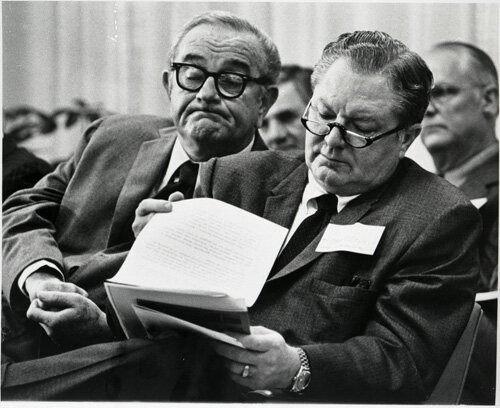During Erwin's regime, his policy on the funds received from oil dividends was, “We do not use our money for social purposes.” following Harvard's policy that their endowment should be used to serve society by maintaining a neutral stance on all political and social issues.
It was difficult to dislike Erwin on a personal basis. Irwin knew how to drink and how to make people laugh. He was skilled at irreverence holding the center court without driving his companions from the gallery.
When Frank Erwin was a Texas student, he suggested to coach D.X. Bible that UT should form a booster club like some other successful football schools. Bible said, “Frank, I’ve never seen an alumni group that didn’t eventually get a school in trouble with the conference or the NCAA.” Erwin responded to Bible, “If he couldn’t proceed with Bible’s blessing, he would proceed without it. He did and succeeded.
In the book “The Forty Acres Follies” by Joe Brantz, the author captures in one sentence the essence of Frank Erwin. “To hell with academic freedom, to hell with student rights, to hell with humanness.” The guy knew how to build, and they applauded. His funding efforts built Bellmont Hall, Disch-Falk Field, the Texas Swimming Center, and the Frank Erwin Special Events Center (the Drum), the fountain facing Sid Richardson Hall, new buildings beyond IH35, the Perry-Castaneda Library, all the new buildings on campus, and the expansion of Memorial Stadium.
His power base included President Lyndon Johnson, Texas Governor John Connally, and Lieutenant Governor Ben Barnes.
Frank was a complicated man who loved the University of Texas. However, there is no question that Frank Erwin had a dark side to his personality and a negotiating style that could be predatory and offensive.
At meetings, Frank scooted down in his chair and glared with a sense of power over his half glasses, ignoring opinions that differed from his. Many thought he was consumed by his power and feared losing it, so he needed an enemy. He needed to save Texas from the progressive students and faculty. He used his power for whatever pleased him. For example, concerning the Longhorn color dilemma in the early 1960s he led the charge to burnt orange. Erwin said, “I suggest that we adopt the standard orange of the orange at the student union. It's not light orange. It's burnt orange or dark orange. I know because I went by yesterday to see it.”
Suffice it to say that Erwin had many enemies who rejected his definition of the mission of an educational system. Those who did not like Frank thought he was Rosemary’s Baby. But discussing the political reign of Erwin’s years as a Regent is beyond the TLSN mission's scope.
U.T. Austin
In Erwin’s 1937 Texas Yell book, Erwin sets the stage for his love of Texas. Frank says, “A university is a benevolent association for the preservation of football.” Frank felt that winning in football would enhance the national Longhorn brand in sports and academics.
The student newspaper said Erwin commented, “We've got some tenured people at Austin I'd like to get rid of, but I'd hate to shut the university down to do it.”
Jenna McEachern says in her book “100 Things” that “Frank C. Erwin was U.’s most visible, active, and divisive regent since the days of Lutcher Stark in the 1920s and 1930s. From 1966 to 1975, he helped set policy- and interfered with every area of campus operations. Erwin was a micromanager…..” “There was no compromise in Erwin. The New York Times called him “a man with gave little quarter to his foes and received little in return.” “Erwin threatened to abolish the Daily Texas editorial page for supporting the first Vietnam war protests on campus.” The chain of command meant nothing to Erwin,” firing people at will, “He was the command. “
Texas is better off today because of his authoritative rule.
“For every villainous act, there was a heroic one. Erwin went to war to protect the Permanent University Fund from being divided among other state schools." Erwin's foremost passion was the University of Texas. When Frank Erwin was named a regent in 1963 until he died in 1983, U.T. essentially became the university we see today. The University campus student population rose from 22,000 to 41,500. Its legislative appropriations rose from $16 million to $100 million, and the campus completed 55 major building projects. On the Austin campus, building contracts amounted to more than $762 million. As square footage increased, so did the system's enrollment -- from 29,940 in 1963 to 77,437 in 1975.
Non-sports construction approved by Erwin included the construction of the Perry Castaneda Library, the College of Fine Arts and Performing Arts Center, Sid Richardson Hall, the Harry Ransom Center, the Education Building, the Grad School of Business Building, Jester Center, the Nursing Building, the Texas Union Renovation, the Welch Hall addition and the wall around the western and southern perimeter of campus.
U.T. System
In addition, from 1963 to 1975, he also was instrumental in building the University of Texas System. Working closely with his political allies in the state legislature, he increased university system appropriations from $40.4 million in 1963–64 to $349.7 million in 1975–76. Much of the money was allocated to expanding the university's physical plant, and the building contracts issued by the regents during Erwin's tenure totaled more than $762 million. Starting in 1967, this University system building program eventually included 12 institutions -Universities and health institutions- with more than ten million square feet of new indoor space for all the U.T. system branches. As a result, the system's enrollment increased rapidly, from 29,940 in 1963–64 to 77,437 in 1974–75, and sports were offered on many of the new campuses such as UTPB, UTSA, UT El Paso, UT Tyler, and many others.
Royal and Erwin respected each other, but there were conflicts.
Erwin controlled almost everyone employed by U.T. except DKR. During DKR's years as head coach, Frank and DKR had several turf battles. During the three years Royal posted 6-4 seasons, Erwin was ready to dump Royal, but the Board of Regents refused.
Then in 1974, Texas got beat by Auburn 27-3, and Frank was not pleased. Evidently, the players were not in shape or mentally prepared to play that game. So Erwin threatened to fire Darrell, and Royal went on the offensive meeting with big-time donors and some regents who assured him he would not be fired. Erwin was not used to losing, but neither was DKR.
In the book, The Forty Acre Follies, the author, Joe Frantz, wrote that Frank Erwin never learned that Regents’ role was to write broad policy but not run the campus's daily operation. The student newspaper said Erwin had said we've got some tenured people at Austin I'd like to get rid of, but I'd hate to shut the university down to do it. When Erwin wanted to get involved in Texas football's daily operations, Royal said no and called on his power brokers to support him.
The Drum
Frank was motivated to build the Drum (Special Events Center). He wanted the Horns to build a basketball dynasty and knew that Gregory Gym was handicapping that process. While Gregory was packed to the rafters with students attending a game, there were not enough “paying” customers in the crowd for Gregory to turn a profit.
Erwin had difficulty convincing the decision-makers to build a basketball facility, so he changed his marketing strategy. He convinced leadership that Austin needed a facility that would advance culture. He focused on the facility as a Special Events Center that would bring in tax dollars from all kinds of venues, such as Rock Concerts, and when there were no special events in the city, the Horns could use the facility to play basketball.




